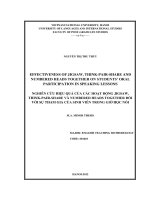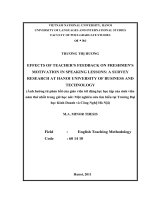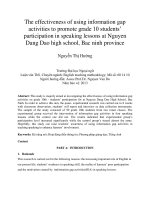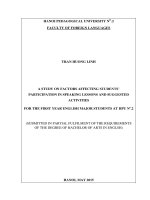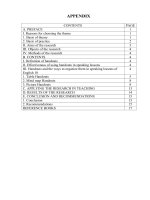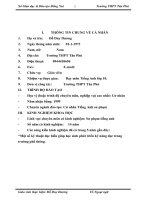How to increase adults participation in speaking lessons an action research project at an english center
Bạn đang xem bản rút gọn của tài liệu. Xem và tải ngay bản đầy đủ của tài liệu tại đây (1.1 MB, 92 trang )
VIETNAM NATIONAL UNIVERSITY, HA NOI
UNIVERSITY OF LANGUAGES & INTERNATIONAL STUDIES
FACULTY OF POST-GRADUATE STUDIES
NGUYỄN THỊ NHÀN
HOW TO INCREASE ADULTS’ PARTICIPATION IN
SPEAKING LESSONS: AN ACTION RESEARCH PROJECT AT
AN ENGLISH CENTER
(Làm thế nào để tăng sự tham gia của người lớn vào các bài học nói:
Một nghiên cứu hành động tại một trung tâm tiếng Anh)
MINOR THESIS
Major : Teaching English Methodology
Code : 8140231.01
HÀ NỘI- 2019
VIETNAM NATIONAL UNIVERSITY, HA NOI
UNIVERSITY OF LANGUAGES & INTERNATIONAL STUDIES
FACULTY OF POST-GRADUATE STUDIES
NGUYỄN THỊ NHÀN
HOW TO INCREASE ADULTS’ PARTICIPATION IN
SPEAKING LESSONS: AN ACTION RESEARCH PROJECT AT
AN ENGLISH CENTER
(Làm thế nào để tăng sự tham gia của người lớn vào các bài học nói:
Một nghiên cứu hành động tại một trung tâm tiếng Anh)
MINOR THESIS
Major
: Teaching English Methodology
Code
: 8140231.01
Supervisor
: PHẠM LAN ANH. PHD
HÀ NỘI - 2019
DECLARATION
I, the undersigned, hereby certify my authority of the study project report entitled
“How to increase adults’ participation in speaking lessons: An action research
project at an English center”submitted in partial fulfillment of the requirements
for the degree of Master in English Linguistics. Except where the reference is
indicated, no other person’s work has been used without due acknowledgement in
the text of the thesis.
Ha Noi, 2019
i
ACKNOWLEDGEMENTS
In the first place, I would like to express my deep gratitude to my supervisor Dr.
Phạm Lan Anh, lecturer of Hanoi Metropolitan University for her invaluable
guidance, insightful comments, invaluable advice, critical feedback and enormous
encouragement. Without her help, I would not be able to complete this paper.
I would like to express my indebtedness to all the lecturers and the staff at the Post
Graduate Studies Department of Hanoi University of Languages and International
Studies for their valuable knowledge and helpful assistance during my period of
studies at the Department. They gave me precious lessons with much invaluable
knowledge for my thesis’s completion.
I also would like to thank the cooperation of my colleagues and learners for their
enthusiastic support in favor of my data collection for the study.
Finally, my appreciation and gratefulness are sent to my family especially my
parents, who have encouraged me to overcome the difficulties in the course of
studying. Without their unconditional love and helpful encouragement, I could not
have the strength and persistence to finish this thesis.
Hanoi, April 2019
Nguyễn Thị Nhàn
ii
ABSTRACT
It is undeniable that speaking participationis important in learning a new language
for communication purpose. Any learners learning a new language should take part
in speaking activities in favor of their speaking improvement. This study entitled
“How to increase adults’ participation in speaking lessons: An action research
project at an English center” focused on how to increase adults' participation in
speaking lessonsby employing communicative activities. In addition, the study was
conducted in the type of action research with 10 participants in one class of the
center. They have completed the interviewin favor of their participation increase to
learn English. The data was collected by interview and class observation. The
process of analyzing and processing data presented that participation level was
significantly improved by the communicative activity application. Finally, it is
expected that the results of this study could be beneficial for development of
teaching and learning at the center.
iii
TABLE OF CONTENTS
DECLARATION ....................................................................................................... i
ACKNOWLEDGEMENTS ..................................................................................... ii
ABSTRACT ............................................................................................................. iii
LIST OF TABLES .................................................................................................. vi
LIST OF FIGURE.................................................................................................. vii
PART 1: INTRODUCTION.....................................................................................1
1. Rationale of the study..............................................................................................1
2. Aims of the study ....................................................................................................2
4. Significance of the study .........................................................................................2
5. Scope of the study ...................................................................................................3
6. Structure of the thesis ..............................................................................................3
PART 2: DEVELOPMENT .....................................................................................4
CHAPTER 1: LITERATURE REVIEW ................................................................4
1.1.1. Definitions of speaking .....................................................................................4
1.1.2. Approaches in teaching and learning speaking skills .......................................5
1.2. Definition of participation ....................................................................................7
1.3. On – task and off – task behavior ........................................................................7
1.4. Communicative activities .....................................................................................8
1.4.1. Definition of communicative activities .............................................................8
1.4.2. Characteristics of communicative activities .....................................................9
1.4.3. Purpose of communicative activities ..............................................................11
1.4.4. Types of communicative activities .................................................................12
1.5. Previous studies on participation in speaking skills...........................................14
CHAPTER 2: METHODOLOGY ........................................................................17
2.1. Participants .........................................................................................................17
2.2. Action research ...................................................................................................17
2.2.1. Rationale for an action research design ..........................................................17
2.2.2. Action research models ...................................................................................18
iv
2.3. Data collection instruments ................................................................................23
2.3.1. Interview .........................................................................................................23
2.3.2. Observation .....................................................................................................24
2.4. Data analysis procedure .....................................................................................24
CHAPTER 3: DATA ANALYSIS AND RESULTS ............................................26
3.1. Answer to the research question 1 .....................................................................26
3.1.1. Results of interview.........................................................................................26
3.1.2. Results of participation observation checklist ................................................35
3.1.3. Results of classroom observation sheet ..........................................................37
3.2. Answer to the research question 2 .....................................................................42
3.2.1. Results of interview.........................................................................................42
3.2.2. Results of behavior observation checklists .....................................................47
PART III: CONCLUSION .....................................................................................51
REFERENCES ........................................................................................................57
APPENDIX ................................................................................................................ I
APPENDIX 1 .............................................................................................................. I
APPENDIX 2: OBSERVATION CHECKLIST.......................................................III
APPENDIX 3: OBSERVATION CHECKLIST...................................................... IV
APPENDIX 4: OBSERVATION SHEET ................................................................. V
APPENDIX 5: SAMPLE OF INTERVIEW QUESTIONS FOR LEARNERS ..... VII
APPENDIX 6: SAMPLE OF LESSON PLAN ...................................................... XII
APPENDIX 7: SAMPLE OBSERVATION CHECKLIST .................................. XIX
APPENDIX 8: SAMPLE OBSERVATION CHECKLIST .................................... XX
APPENDIX 9: DATA COLLECTED IN THE OBSERVATION CHECKLIST
FOR PARTICIPATION LEVEL ......................................................................... XXII
APPENDIX 10: DATA COLLECTED IN THE OBSERVATION CHECKLIST
FOR BEHAVIOR ............................................................................................... XXIII
APPENDIX 11: DATA COLLECTED IN THE OBSERVATION SHEET......XXIV
v
LIST OF TABLES
Table 2.1: Implementation plan ................................................................................20
Table 3.1: Checklist for participation .......................................................................35
Table 3.2: Number of on - task times (Lesson 2- initial data) ..................................37
Table 3.3: Number of on - task times (Lesson 3 - initial data) .................................38
Table 3.4: On – task counts .......................................................................................40
Table 3.5: Learner initiative ......................................................................................47
Table 3.6: Interruption limitation ..............................................................................49
Figure 3.4: Behavior level .........................................................................................50
vi
LIST OF FIGURE
Figure 2.1: Action research cycle (Kemmis and Mc Taggart) ..................................19
Figure 3.1: Overall participation ...............................................................................36
Figure 3.2: Initial data ...............................................................................................39
Figure 3.3: On – task level ........................................................................................41
vii
PART 1: INTRODUCTION
1. Rationale of the study
English has become increasingly important to one’s success in the society since
mastering it would open more opportunities for both working and studying. English
has been a compulsory subject and an important task in the education and training
of each country, including Vietnam. A lesson in general, an English speaking in
particular cannot be admitted as successful one without learners’ active
participation. Among for English skills, speaking skills are the most important to
assess who know or don’t know to communicate and their understanding of such
language.
At the center, the learners where the researcher works have studied English before,
but they are shy to speak in the classroom. In the writer’s teaching experience, it is
found that herlearners has the following problems in participation in speaking
English in class. (1) They and their previous teachers only paid attention to learning
vocabulary and grammar to master English drills in written form. Other skills that
did not serve for testing purpose such as speaking were ignored. (2) Inactive
participation in communicative activities occurred very often as well as they are
afraid of speaking wrong. (3) They do not have suitable learning methods and
appropriate activities for speaking motivation. Some of them are very good at
grammar; they usually gain high scores in English, but only in paper tests whereas
in real life they speak very poorly. Learning English in Vietnam has been conducted
by traditional ways in which learners are very passive and do not have a
communicative environment causing their ineffective speaking and boredom to
participate in speaking English.
From all above reasons, the writer would like to study how to increase adults'
participation in speaking lessons; therefore, an attempt has been made to carry out
an action research project at an English center. The further purpose of the study is to
figure out appropriate strategies to enhance speaking participation for adult learners
1
as well as raise their awareness toward the importance of communicating English in
the class and in real life.
2. Aims of the study
The study aims at improving the adult learners’ participation in speaking lessons at
an English center in Hanoi by employing the communicative activities through an
action research project.
The main research questions that need to be answered over the study are:
Question 1: How do the communicative activities help improve the learners'
participation in speaking class?
Question 2: What are the learners' attitudes towards the communicative activities?
3. Objectives of the study
This study is conducted to investigate the relationship between the communicative
activities and participation increase in the English class for adults. The main
objectives are:
To investigate whether the communicative activities is integrated into the class.
To investigate whether the communicative activities improve the learners’
participation in speaking lessons.
To investigate whether the communicative activities have effective influence on the
learning and teaching speaking English.
4. Significance of the study
The study shows the importance of participation in speaking in order to
maximizethe learners’ ability to communicate in English. Providing a positive and
motivating classroom by teachers and educational authorities seems to be an urgent
necessity and there is a need to point out the effective teaching and learning
strategies. To put it more specifically, the findings of the study would hopefully
help teachers and learners in their teaching as well as learning communicative
English. In other words, the learners’ participation keeps learning going in the right
direction. Through this, the teacher learns how to involve their learners in their
activities so as to stimulate speaking.
2
5. Scope of the study
This study was conducted with 10 people aged from 18 to 40 for speaking lessons
within 4 months at an English center. There are many factors related to speaking
skills but this study aims to increase speaking participation. Therefore, the
researcher only focuses on the employment of the communicative activities to
increase the adults' engagement in speaking lessons. Finally, classroom observation
and interview are employed in favor of data collection and analysis.
6. Structure of the thesis
The study report consists of three parts: Introduction, Development and Conclusion.
PART 1 - INTRODUCTION summarizes all the main purpose and issues that the
research aims to address as well as the most outstanding findings. Also, the writer
presented the related researches and issues about the same focuses; It provides a
general introduction on the background of the topic along with its aims, research
questions and the design.
PART 2 - DEVELOPMENT is the main part of this thesis. It contains three chapters
namely
Literature
Review,
Methodology
and
Major
Findings
and
Recommendations,
Chapter 1 - Literature Review starts with the information on understanding general
knowledge relevant to speaking, including the definition of participation, and
speaking. Then comes the literature on the communicative activities consisting of
its definition and types. The rest of the chapter is on previous studies related to
using them during speaking.
Chapter 2 - Methodology presents the methodology conducted in the study,
including key elements of an action research project, background information of the
participants and setting of the study; the use of the instruments for data collection
and the procedure. Added to that, action research procedures are also presented in
this chapter.
PART 3 - CONCLUSION consists of the summary, findings and limitations of the
research.
3
PART 2: DEVELOPMENT
CHAPTER 1: LITERATURE REVIEW
This chapter provides the literature review related to theoretical frameworks in
connection withspeaking and the communicative activities used in the research
process. In each section, the definition or explanation of the key terms also
presented together with the studies worldwide.
1.1. Speaking
1.1.1. Definitions of speaking
According to Ladouse (1991), speaking is described as the ability to express oneself
in the situation, or the activity to report acts, or situation in precise words or the
ability to converse or to express a sequence of ideas fluently. This means that
speaking skills occupy an important position in expressing a person's understanding,
knowledge and competence.
In addition, Burns and Joyce (1997) consider speaking as an interactive process of
constructing meaning that involves producing and receiving and processing
information. Its form and meaning are dependent on the context in which it occurs,
including the participants themselves, their collective experiences, the physical
environment, and the purposes for speaking. It is often spontaneous, open - ended,
and evolving. However, speech is not always unpredictable.
Furthermore, Florez (1999) defines speaking as a two – way process involving a
true communication of ideas, information or feelings. This top - down view
considers the spoken texts the product of cooperation between two or more
interactants in shared time, and physical context. Thus, proponents of this view
suggest that, rather than teaching learners to make well - formed sentences and then
putting these to use in discourse we should encourage learners to take part in spoken
discourse from the beginning and then they acquire the smaller units.
Last but not least, Brown (1994) also expresses his point of view on speaking as an
integrated element in connection with writing, reading and listening. Therefore, it is
4
essential for teachers and learners to focus on the interrelationship of those ones.
1.1.2. Approaches in teaching and learning speaking skills
Speaking is one of the most important skills which must be focused and enhanced in
light of its effectiveness on communication. However, it is also considered one of
the most difficult aspects of the language learning process. Many learners find it
hard to fully express their thoughts in English even though they have been learning
the language for many years. Therefore, improving the learners' speaking
participation for their fluent communication is an important goal in the current
foreign language program. As a result, many approaches are researched and applied
to enhance the effectiveness of teaching and learning English speaking skills. Some
of the typical ones are mentioned subsequently:
1.1.2.1. Teaching and learning speaking in traditional approach
Teaching approaches play an important role in improving the quality of English
training in general and speaking skills in particular. Teaching is the process of
helping and guiding learners to acquire content and knowledge. Traditional
approaches are considered as the process of transmitting knowledge from teachers
to learners by note and almost teacher - centered education, in which learners put all
of their focus on the teacher. In other words, the teacher talks and the learners
exclusively listen. One of the traditional approaches to teach and learn speaking are
detailed as follows:
Grammar – translation
According to Rosamond (1988), grammar – translation approach involves the direct
translation of sentence after sentence as a way to learn language. This method
assumes that learners are aiming for mastery of the target language, and they are
willing to study for years before expecting to use the language in real life. However,
these assumptions are challenged by adult learners, who are busy with work, and
some schoolchildren, who are less academically gifted, and thus cannot devote
years to learning before being able to use the language.
Added to that, Zhou (2015) states grammar – translation method is a method of
5
teaching foreign languages derived from the classical (sometimes called traditional)
method. In grammar – translation classes, learners learn grammatical rules and then
apply those rules by translating sentences between the target language and the
native language. Advanced learners may be required to translate whole texts word for - word. The method has two main goals: to enable learners to read and translate
literature written in the source language, and to further learners' general intellectual
development. Actually it focuses on reading and writing, vocabulary is determined
by reading the text, sentence is the basic unit of teaching and language practice.
Next, the primary emphasis is on accuracy. Speaking consists largely of reading
translations aloud or doing grammar exercises orally.
1.1.2.2. Teaching and learning speaking in communicative approach
According to Chomsky (1957), communicative approach or communicative
language teaching (CLT) is an approach to language teaching that emphasizes
interaction as both the means and the ultimate goal of study. Today, a lot of
linguistics and ESL (English as a second language) teachers agree that learners
learn to speak in the second language by interacting. Communicative language
teaching and collaborative learning serve best for this purpose. This means that
when teaching and learning speaking skills through real life, learners are given
chances to use the target language for communication with others in class as well as
to make a situation for their creative activity. In other words, a teacher should create
an environment where learners apply what they learn in real life communication,
authentic activities, meaningful tasks and materials in order to increase speaking
participation.
In addition, Nunan (1991) shares learners converse about personal experiences with
partners, and instructors teach topics outside of the realm of traditional grammar in
order to promote language skills in all types of situations. This method also claims
to encourage the learners to incorporate their personal experiences into language
learning environment, and to focus on the learning experience. They learn and
practice the target language through the interaction with others and the instructor,
6
the study of authentic texts (those written in the target language for purposes other
than language learning), and through the use of the language both in class and
outside of class.
1.2. Definition of participation
According to Topping (2005), learner participation is defined as an involvement of
learners in order to learn. Participation can be identified in terms of three kinds:
learner to teacher, learner to learner and learner to material.
For learner to teacher, the learner tries to maintain a constant and positive
interaction with the teacher who is considered to be the active participant in
speaking activities and care about things like asking questions, sharing personal
views or experiences. Rather, participation is not just about being on time or
attending until the class ends, recording everything the teacher writes on the board
but also responding to any contents during the learning process.
Learner to learner is the interaction between learners. They tend to discuss or
contribute their ideas in pair or in group activities. It can be said to be peer - to peer learning.
The last type of interaction is learner to material, it is considered as a form of
interaction between learners and material that means learners actively complete
reading activities.
To sum up, learners and teacher have different roles, but can work together to make
education better and more exciting. Even and effective participation depends on
both parties.
1.3. On – task and off – task behavior
According to Hastings and Schwieso (1995), on - task behavior is a term used to
describe how learners spend a lot of time actively on teacher - initiated activities.
This type of behavior has been considered as commenting on related topics,
participating in discussion, reading aloud, raising hands, working on assigned
activity and making eye contact with the teacher.
Furthermore, Chapman (2003) shareslearner engagement has been used to depict
7
learners’ willingness to participate in routine class activities, such as attending,
submitting required work, and following teachers’ directions in class. Learners'
participation measurement is frequently applied by scanning number method by
Peacock.
The opposite of on – task behavior is off – task. Baker (2007) defines off - task
behavior in learning environments as behavior “where a learner completely
disengages from the learning environment and task to engage in an unrelated
behavior”. In other words, off - task or inattention has been shown to negative
behaviorin learning. In teaching and learning speaking skills,it is essential to be
attentive and actively engaged in lessons. This focus is defined as a learner
participates in a behavior that is not related to the activity assigned by the teacher.
This definition is close to relatively low forms of behavior like day – dreaming,
looking around the classroom, using materials ort equipment incorrectly, talking
with other without the teacher’s request, passing notes, dozing etc.
This study focuses on increasing on - task performance in speaking lessons by
applying the communicative activities.
1.4. Communicative activities
It is obvious that communicative activities are significant in improving the quality
of English teaching and learning. The organization of these activities in a diverse
and regular manner helps class environment become livelier, more comfortable and
learners are more active and confident in using language. These activities are
mainly organized in the form of group and pair activities helping the learners have
opportunities to develop group work skills, be more confident, active and supportive
to practice these knowledge learned more.
1.4.1. Definition of communicative activities
Richards
(2006) defines
that
communicative language teaching
can
be
understood as a set of principles about the goal of language teaching, how
learners learn a language, the kind of classroom activities that best facilitate
learning, and the role of both parties.
8
Similarly, Hadfield (1999) states that communicative activities focus on helping
learners to communicate meaningfully in a target language rather than just grammar
or writing. This makes speaking lessons more interesting, as a bridge between the
classroom and the world outside. Or it is characterized language teaching as the
development of communication skills. The communicative activities are employed
to enhance learners’ communicative competence.
According to Harmer (2007), communicative activities involve a variety of
language, no teacher intervention, no material control, and focus on both form and
meaning. In order to carry out communicative activities, learners should have a
desire to convey something with a communicative purpose.
To sum up, communicative activities are intended to promote a targeted interaction
between two or more learners and a significant piece of comprehension for learning
second language. Furthermore, they are means of supporting for life communication
and creating a context for an activity. It is clear that communicative activities are
necessary for pedagogic purposes.
1.4.2. Characteristics of communicative activities
Communicative activities are able to encourage learners to use language and bring
motivation to communicative with other by dint of their aim for speaking and
creating interaction. According to Littlewood (1991), communicative activities can:
(1) provide “whole - task practice”; (2) improve motivation; (3) allow natural
learning; (4) create context which support learning.
Furthermore, Sun and Cheng (2000) point out three features of communicative
activities. Firstly, communicative activities are task - based. Task - based English
teaching focuses on communicative tasks that learners need to participate in outside
activities. Secondly, communicative activities are learner - centered. The emphasis
of teaching activity is on learners’ initiation and interaction. They are expected to
take part in the activities as real people and be in charge of their learning. Thirdly,
communicative activities emphasizes the use of authentic language input and the
teacher’s native or near native language competence in order to produce
9
communication in the classroom.
According to Hammer (1991), communicative activities have six characteristics as
follows:
Non – communicative activities
Communicative activities
- No communicative desire
- A desire to communicate
- No communicative purpose
- A communicative purpose
- Form not content
- Content not form
- One language item only
- Variety of language use
- Teacher intervention
- No teacher intervention
- Material control
- No material control
It is obvious to see the differences between communicative and non communicative activities. In the former, learners must have the need and desire to
communicate with others in class and communicative purposes are also mandatory.
With this characteristic, motivation is also one of the deciding factors. In the
process of communication, learners are interested in the content discussed rather
than grammar or in other words the form. The content conveyed to listeners is
important. Besides, they must maximize the time to use the language. Perhaps, that
is also the additional reason for the characteristic of “content not form” above.
Communicative activities promote and focus on learner – centered education.
Teachers would not interfere with grammatical or pronunciation mistakes that
interfere
learners’
participation
in
speaking
activities.
In
other
words,
communicative activities maximize learners’ autonomy when learners are engaged
in relevant tasks within a dynamic learning environment instead of traditional –
approach classes. Last but not least, learners do not use material to control the
language. This means that they have to try to speak as naturally as possible and real
communication situations should be the focus during the course.
To sum up, communicative activities motivate learners to complete concrete
outcomes and express language without any limitations as well as facilitate them to
participate in speaking lessons effectively.
10
1.4.3. Purpose of communicative activities
Communicative activities play a crucial role in communicative language teaching.
William Littlewood (1981) summarizes some purposes of communicative activities
as follows:
Whole – task practice
In considering how people learn to carry out various kinds of skilled performance, it
is often useful to distinguish between (1) training in the part-skills of which the
performance is composed and (2) practice in the total skill, sometimes call “whole task practice”. In foreign language learning, our means for providing learners with
whole - task practice in classroom is through various kinds of communicative
activity, structured in order to suit the learners’ level of ability.
Motivation improvement
Learners’ ultimate objective is to take part in communication with others. Their
motivation to learn is more likely to be sustained of they can see how their
classroom learning is related to this objective and helps them to achieve it with
increasing success.
Also, most learners’ conception of language is as a means of communication rather
than as a structural system. Their learning is more likely to make sense to them if it
can build on this conception rather than contradict it.
Allowance of natural learning
Language learning takes place inside and many aspects of it are beyond their
pedagogical control. It is likely, in fact, that many aspects of language learning can
take place only through natural processes, which operate when a person is involved
in using the language for communication. Communicative activities (inside or
outside classroom) are an important part of the total learning process.
Context creation for learning support
Communicative activities provide opportunities for positive personal relationship to
develop among learners and between learners and teachers. These relationships can
help to “humanize” the classroom and to create an environment that supports the
individual in his efforts to learn.
11
1.4.4. Types of communicative activities
Littlewood (1981) distinguishes two types of communicative activity to be
performed by communicative language learners. Those are the functional
communication activities and the social interaction activities. The classroom needs
communicative activities that emphasize the functional aspect of communication.
Therefore, for example, when learners have a problem to solve, or information to
exchange, they can use whatever language they have at their disposal. That is, the
main purpose of the activity is that learners should use the language they know to
get meanings across as effectively as possible. This means that language learning
activities should be done in their real context so that language learners may not be
disgusted thinking that the language they are learning cannot satisfy any of their real
communication needs.
Based on the above two criteria, the following activities are applied during the
research process:
Brainstorming
Brainstorming is an activity used to generate ideas in small groups. The purpose is
to generate as many ideas as possible within a specified time - period. These ideas
are not evaluated until the end and a wide range of ideas is often produced. Each
idea produced does not need to be usable. Instead, initial ideas can be viewed as a
starting point for more workable ideas. The principle of brainstorming is that
learners need lots of ideas to get good ideas. On a given topic, they can produce
ideas in a limited time. Depending on the context, either individual or group
brainstorming is effective and they generate ideas quickly and freely. The good
characteristics of brainstorming are that they are not criticized for their ideas so
learnersare open to sharing new ideas.
Role play
Blatner (1991) sees role play as a methodology derived from sociodrama that may
be used to help learners understand the more subtle aspect of literature, socio
studies, and even some aspect of science or mathematics. Furthermore, it helps them
12
more interested and involved, not only learning about the material, but learning also
to integrate the knowledge in action, by addressing problems, exploring alternatives,
and seeking creative solutions. Role play is the best way to develop the skills of
initiative, communication, problem solving, self - awareness, and working
cooperatively in teams. It might contain a discussion on practical issued, with each
person assigned to represent a practical point of view.
Information gap
According to Nunan (1989), information gap task can act as a nucleus around which
is range of other tasks and exercise types can be constructed. Also, he states
information gap activities are designed to take learners one stage further towards
being able to handle more realistic communication. By such reasons, require
learners to communicate with each other in order to find all the necessary
information to complete the activity. Each partner has information that other does
not. It is very essential that they have the appropriate level of language in order to
complete the activity. It is considered as the most useful and effective tool for
teachers to bring features of real life communication into classroom context.
Additionally, it encourages participants to exchange information to provide
solutions or problems in speaking. Therefore, this is an effective way to improve
communication in class as well as in groups. Information gap activities are
considered the best solution to help them become more confident, motivate
learners’ participation and provide them with meaningful language practice.
Problem solving
Problem solving is a mental process and is part of the larger problem process that
includes problem finding and problem shaping. Considered the most complex of all
intellectual functions, problem solving has been defined as higher - order cognitive
process that requires the modulation and control of more routine or fundamental
skills. Problem solving activities can be used at all levels. Regarding learner’s
knowledge of English, age and their experience, appropriate activities might be
successfully applied. It is also important to work out clear and easy directions for
13
these activities. It can be a picture shown on the active - board, or a video. The
teacher may ask low level learners to describe the picture, when high level learners
may pay more attention to the situation, shown in the picture. The questions help
learners to review some grammar, which can be used in the process of discussion.
Problem solving techniques focus on the group’s solution of a concrete problem. It
may be quite simple such as giving directions on map, or complicated such as
finding an itinerary from transportation journey.
Presentation
Presentation is extremely useful both inside and outside classroom. After being
guided by specific steps, suggestions or ideas for a topic, learners can make a
presentation on simple topics. It is considered as a channel for them to share with
others what they have learnt. It also a great chance to challenge and expand their
understanding of the topics by asking and answering questions related. The
audiences can plan a task, for example, making a set of questions for the
presentation, or filling in a peer assessment sheet, which is a way of attracting their
attention.
1.5. Previous studies on participation in speaking skills
A great deal of studies on speaking skills and participation has been conducted in
order to improve this area in the world up to the present. In terms of participation
increase in speaking lessons, some researchers believe that active participation in
speaking is closely related to motivation and application of communicative
activities.
A related study was conducted by Hoang (2009) to investigate participation
motivation of sophomores at Sao Do College of Industry. Questionnaire, interview
and class observation were applied during this study as key instruments. Over 60
learners were selected by random for the population of the study as well as 6
teachers. Results showed that motivation played an important role in improvement
of speaking participation. In addition, aptitude and vocabulary were also factors that
determine the learning outcomes.
14
Also, Chau (2013) undertook a study on speaking participation. Observation and
questionnaire were instruments to collect data during the experiment. The data
analysis presented that speaking participation was increased by information gap,
discussions, role play and class survey. The results expressed the teacher and
learners’ positive attitude towards speaking lessons through the communicative
activities. Most of the learners were interested in speaking lessons so they were
willing to join the activities. Moreover, the teacher followed closely their learners
then had suitable teaching methods. In speaking lessons, the teachers usually had
appropriate kinds of class arrangement that met their learners’ interest.
Furthermore, Tran (2005) conducted an experiment with the use of group work and
communicative activities techniques to increase students’ speaking participation in
large classes at Thai Nguyen College of Education. After the application, she
concluded that these techniques had a positive effect on the students’ engagement.
Similarly, the results from the learner’s attitude questionnaire also had encouraging
outcomes. This gave the learners
opportunities and supportive atmosphere to
practice a variety of activities and in accordance with their needs and interest.
In addition, Hadriana (2008) conducted the study on participation with 36 students.
Oral presentation tests and observation sheets were employed to collect data. After
conducting the classroom action research in teaching speaking by applying the
communicative activities, the research was successful in improving speaking
participation. The researcher has to continue conducting further research and
applying the communicative activities in small group discussions to other language
skills such as listening, reading and writing.
Added to that, César Ochoa (2016) sought to shed light on the relationship between
communicative activities and the participation of 180 senior high school learners.
Questionnaire and face - to - face interview were applied to obtain data concerned
with use of the communicative activities in the classroom and their relation with
participation. The data gathered was analyzed using a mixed - method approach,
comprising quantitative and qualitative methods. Results showed that the
15
communicative activities were motivating. Furthermore, the students felt highly
motivated when participating in the communicative activities because these
improved their fluency, pronunciation, and performance in the use of English in a
realistic and enjoyable ways.
From the studies above, it is possible to see that using communicative activities is
an effective way to improve learners’ participation in speaking English. Overall,
enhancing learners’ participation to improve their speaking skills is not new but it
requires constant change and effort between teachers and learners. However, the
issue of raising participation for adult learners seems to have not really been taken
into account in recent studies. This is a gap for this study to bridge.
1.6. Chapter summary
This chapter gives a detailed description of the theoretical background considered as
the foundation of this present study. The first part describes conceptualization
speaking skills as well as factors related to speaking skills. Followings are the
approaches and techniques, their features also presented to enhance the learners'
participation. In the last part, the concept of participation and previous studies were
performed with communicative activities in teaching English and learners’ behavior
towards communicative language teaching was presented in detailed.
16
